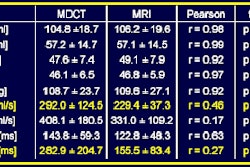In a new study of elite athletes, those with linear parasymphyseal T2 hyperintensity seen on pubic bone MRI were more likely to have to restrict their training due to groin pain. But imaging didn't predict which pros would be sidelined from the intense, rugby-like matches of Australian Rules football.
Fifty-two men from two Australian Football League teams participated in the study led by radiologist Dr. John Slavotinek at Flinders Medical Centre in Bedford Park, South Australia (American Journal of Sports Medicine, June 2005, Vol. 33:6, pp. 894-899).
The players were followed through their 25 matches of the regular season and finals. Team physicians were unaware of the MR findings. An athlete's training was considered restricted when groin pain prevented them from completing the same regimen as their fellow players.
By the end of the season, 22 (42%) of the athletes had experienced at least one period of restricted training due to groin pain. "Missed games were less common and were observed in 9 (17%) of 52 footballers," the researchers reported.
The prospective study began with all participants undergoing a clinical exam by a sports medicine physician who had no prior knowledge of their medical history. Although 41 of the 52 athletes had current or previous bouts of groin pain, all were able to train fully at the time of their evaluations, conducted after six weeks of preseason training.
The clinical exams documented preseason groin pain in 23 (44%) and pubic bone tenderness in 39 (75%) of the 52 athletes.
MR scans were performed a median of six days after the clinical exams. Half were conducted on a 1.0-tesla scanner (Impact, Siemens Medical Solutions, Erlangen, Germany) and half on a 1.5-tesla scanner (Signa, GE Healthcare, Chalfont St. Giles, U.K.), which the researchers deemed equally sensitive for the MR findings relevant to their study.
Scanning involved T1 spin-echo and fat saturation T2 fast or turbo spin-echo sequences in planes axial and coronal to the body of the pubis. T1-weighted spin-echo images were performed with a repetition time of 440-688 msec, echo time of 20 msec, 4-mm slice thickness, 20-cm field-of-view, and 256 x 512 matrix. Fat saturation T2-weighted images were performed with a repetition time of 4,000-6,002 msec, echo time of 66-112 msec , 4-mm slice thickness, 20-cm field-of-view, and 224 to 240 x 256 matrix.
The MR images showed bone marrow edema greater than 2 cm in 19 (37%) of the 52 athletes. But it was present in only 11 (50%) of the 22 athletes who missed some training, "and accordingly, no association between bone marrow edema and training restriction was demonstrated," the authors noted.
The authors noted that the insignificance of bone marrow edema wasn't surprising, given earlier studies showing that it persists for up to two years after osseous trauma.
Conversely, linear T2 hyperintensity seen on MRI was found to be associated with subsequent training restrictions (p = 0.01). It was visualized in 16 (31%) of the athletes, and was bilateral in seven (44%) of those 16 cases.
"Such linear hyperintense signal was invariably paracortical in location," the authors noted. "A hypointense line suggestive of established stress fracture was observed immediately adjacent, with linear T2 hyperintensity in five (31%) of the 16 cases."
Also seen among the 16 cases with linear T2 hyperintensity were prominent superior pubic osteophytes (pubic beaking) in eight cases (50%) and subchondral cysts in seven (44%).
Groin pain and pubic bone tenderness noted in the preseason clinical exam were also associated with missed training, with the former showing a much stronger association than the latter (p = 0.0004 versus p = 0.02). Preseason pain was also the only predictor of missed matches (p = 0.03).
But the clinical and MRI associations that were found were deemed useful by the researchers.
"These observations are encouraging because preseason findings have been identified that indicate that an athlete is likely to experience athletic limitation during the subsequent season," the authors wrote.
"This information introduces the possibility that intervention in the preseason may result in improved athletic capacity and performance during the season," they concluded.
By Tracie L. Thompson
AuntMinnie.com staff writer
July 1, 2005
Related Reading
MRI pulls its weight in pectorals, August 25, 2004
CT: An all-star modality for C-spine trauma? August 18, 2004
Proper positioning for the pelvis and proximal femur, August 8, 2003
In hockey, frustration is often spelled G-R-O-I-N, February 11, 2002
Copyright © 2005 AuntMinnie.com


.fFmgij6Hin.png?auto=compress%2Cformat&fit=crop&h=100&q=70&w=100)





.fFmgij6Hin.png?auto=compress%2Cformat&fit=crop&h=167&q=70&w=250)











